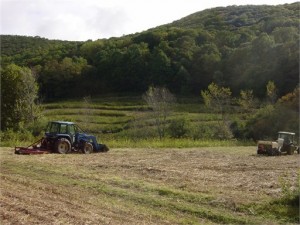A North Carolina Wildlife Resources Commission (NCWRC) press release on December 9 announced that work was underway, “…to restore habitat by promoting new forest growth for wildlife,” on the Catpen project. The Catpen area is on the south side of Bluff Mountain in the Appalachian Ranger District of the Pisgah National Forest near the Tennessee – North Carolina border, just north of Max Patch in Madison County.
The Catpen project is unique. It’s the first project to be implemented via the master stewardship agreement between the USDA Forest Service and the NCWRC, which is the first master stewardship agreement in the country between the USDA Forest Service and a state agency.
Smoky Mountain News (SMN) first reported on these innovative stewardship contracts in the January 19 edition in the article “Logging for cash versus long-range forest health.” That article can be seen online at http://www.smokymountainnews.com/advertise/item/3072-logging-for-cash-versus-long-range-forest-health?tmpl=component&print=1.
Some of the differences between conventional timber-bids and stewardship contracting pointed out in that article include:
“The new approach means the forest service can award bids based on the “best contract” rather than the most money, Remington [Dale Remington, sales forester for the National Forests in North Carolina] said. The contract could go to a timber company, but could likewise be awarded to an environmental group or hunting club.
“Under stewardship contracts, the Forest Service could lay out the goals and objectives and let the contractor tell them how they planned to achieve those goals, he said. And unlike the traditional timber sale, those goals could even include wildlife diversity and protecting old growth stands.
“Stewardship contracts can also be spread over a larger area than conventional timber sales. Most conventional timber sales are confined to only the specific area the logging will be done. Most of them impact around 150 to 250 acres. Under stewardship contracts, the Forest Service designates the stewardship area and it can range from a simple stream corridor to an entire basin encompassing 2,000 or more acres.”
Another difference between conventional timber sales and stewardship contracting was pointed out in SMN’s February 16 Naturalist’s Corner, “Time to shift gears” – http://www.smokymountainnews.com/news/item/3268-time-to-shift-gears – ; “…most of the money stays in the region rather than going to the U.S. Treasury and can be used for other restoration projects across the forest.”
The first phase of the Catpen project affects about 15 acres and according to NCWRC’s Gordon Warburton, will “…benefit deer, turkey, grouse, bears, neotropical songbirds and other species.” The second phase of the project is designed to enhance Max Patch Pond.
I commend NCWRC for capitalizing on this new tool for forest management. I spoke with Dale Remington back in February when I did the Naturalist’s Corner column and he assured me then that he and the Forest Service were open to stewardship contracts with organizations like The Nature Conservancy, Wild South and others and that the focus of such contracts was the overall health of the forests of North Carolina and beyond.
I hope to have the opportunity to write about such a project soon.

